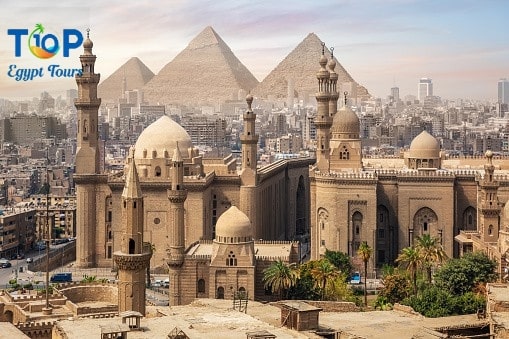Cairo is the capital of the Arab Republic of Egypt and its largest and most important city ever. It is the largest Arab city in terms of population and area, and it occupies second place in Africa and only twenty-seventh in terms of population.
The city of Cairo has several famous names, including Egypt Al-Mahrousa, Cairo of Al-Moez, the City of a Thousand Minarets, and the Jewel of the East.
History of Cairo:
The history of the city dates back to the founding of the Pharaonic city of On or Heliopolis (currently Ain Shams), which is considered the oldest capital in the ancient world. As for Cairo in its current style, its establishment dates back to the Islamic conquest of Egypt at the hands of Amr ibn al-Aas in 641 AD and his establishment of the city of Fustat, then the Abbasids’ establishment of the military city, then Ahmed ibn Tulun’s construction of the city of al-Qata’i. With the entry of the Fatimids into Egypt, Commander Jawhar al-Siqilli began building the new capital of the Fatimid state by order of the Fatimid Caliph al-Muizz li-Din Allah in 969 AD, and the Caliph called it “Cairo.” Throughout the ages, Cairo has been given many names: the City of a Thousand Minarets, the Guarded Egypt, and the Cairo of the Moez.
During the Islamic era, Cairo witnessed the finest architecture, represented by the construction of castles, forts, walls, schools, and mosques, which gave it an aesthetic profile that is still present in its ancient neighborhoods until now.
The cities of Cairo and Giza are full of many archaeological sites, including:
On city:
It is one of the most important Pharaonic archaeological areas and is known as Ain Shams or Heliopolis. It is considered one of the oldest capitals in the ancient world. One of its most important archaeological landmarks is the Obelisk of King Senusret I or the Obelisk of Matariya, which is the only remaining monument of this city’s landmarks.
Giza Pyramids area:
The three pyramids of Khufu, Khafre, and Menkaure are considered one of the Seven Wonders of the Ancient World. They are also considered a unique architectural achievement, testifying to the magnificence and greatness of Egypt, and the Sphinx stands guarding them.
Egyptian Museum
The Egyptian Museum in Tahrir is one of the tourist places that contains many pieces of Pharaonic antiquities, and each piece has information about it next to it.
National Museum of Egyptian Civilization
The National Museum of Egyptian Civilization is one of the tourist places that contains many distinctive artifacts. Next to each piece is an explanation of its history, in addition to visiting the royal mummies and learning about their history and the battles they fought in order to defend their homeland. After completing the visit, you can sit in the restaurant or buy gifts. Souvenir.
Moez Street
Al-Muizz Street is considered an open museum containing many archaeological sites that were built during the reign of one of the kings and sultans.
Amr Ibn Al-Aas Mosque in Fustat
Amr ibn al-Aas Mosque, built in the city of Fustat, which was founded by Muslims in Egypt after its conquest. It was also called the Al-Fatah Mosque, the Old Mosque, and the Crown of Mosques. Amr ibn al-Aas Mosque is located east of the Nile.
Ahmed Ibn Tulun Mosque
Ahmed Ibn Tulun Mosque is the third mosque established in Islamic Egypt. It was established by Ahmed Ibn Tulun to be a comprehensive mosque for Muslims to meet in Friday prayers. Its area is about six and a half acres. Ibn Tulun’s upbringing in Iraq had an impact on transferring Iraqi architectural styles to Egypt during his reign and the emergence of those influences on architecture. The mosque, whether in terms of design or in terms of planning and decoration, has a part of a marble plaque in the eastern portico that includes the name of the builder and the date the mosque was established, written in Kufic script.
Mohamed Ali Mosque
Muhammad Ali Mosque is located inside the Citadel of Salah al-Din al-Ayyubi in Cairo. This mosque was built during the reign of Muhammad Ali Pasha in 1848 AD on the site of the Mamluk palaces, and it is considered the most prominent mosque in Egypt that is distinguished by its archaeological character.
The mosque was designed to resemble the Ottoman style, and the mosque is made of limestone, which is the main material for construction.
Sultan Hassan Mosque
If the pyramids are the most awe-inspiring feature of ancient Egypt, then the Sultan Hassan Mosque is Egypt’s Islamic school and the most famous monument in the Islamic world.
The Sultan Hassan School or Mosque, this giant edifice, was founded by Sultan Hassan, son of the great Mamluk Sultan Al-Nasir Muhammad bin Qalawun, in 1361 AD, and work on it continued for 4 years. Sultan Hassan died before the work on it was completed.
So get ready to embark on an enchanting journey, where ancient wonders and modern vibrancy coexist in harmony, as we delve into the captivating tale of Cairo’s past and present.



Comment (0)